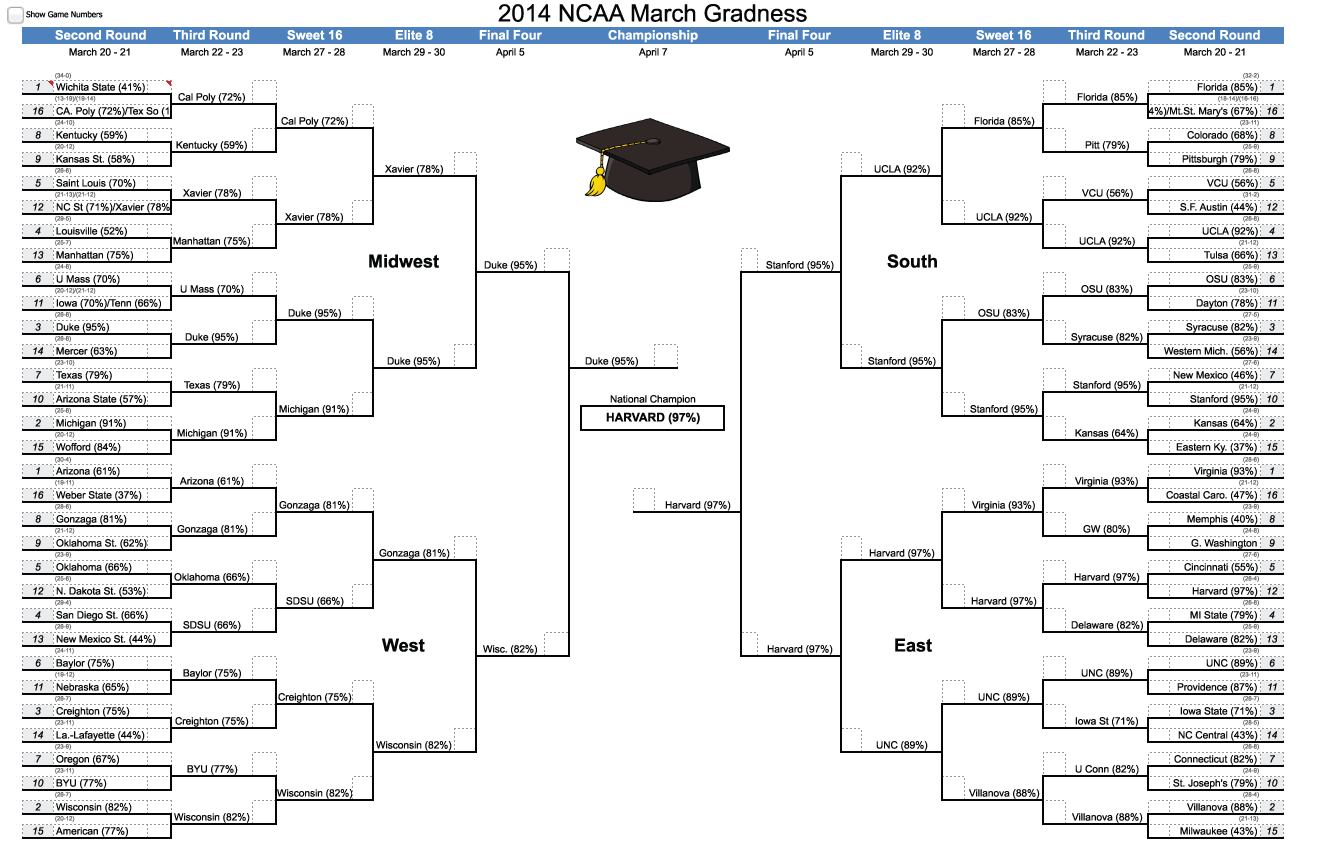March gradness: An NCAA bracket built on grad rates, not victories

So, everybody’s NCAA bracket is ruined by now, right? OK, let’s try a different kind of bracket.
Let’s cancel March Madness.
Instead, let’s fill out a bracket about something that might actually matter to the American economy. Something that has far more impact on the student sections than the final scores of all those basketball games. A deeper level of accountability than who out-rebounded who in Madison Square Garden.
Let’s play “March Gradness.”
Here’s how it works… Same schools and pairings as this year’s NCAA men’s basketball championship. But to survive and advance your school has to have the better student graduation rate for all full-time students.
There were a few “overtime” games in March Gradness – tie scores between schools with equal graduation rates. In those cases, African-American grad rates were used as a tiebreaker. Our data came from the Integrated Post-Secondary Education Data System. We used the published six-year graduation rate for full-time students. And special thanks to the technology company Vertex, which publishes a nifty NCAA bracket each year which we adapted to the purpose of March Gradness.
You can download a PDF of the results here.
Harvard, with a 97 percent graduation rate, beats Duke (95 percent) in the national championship. Stanford (95 percent) and Wisconsin (82 percent) round out the Final Four. Wisconsin is the only team this year to make the Final Four of both March Madness and March Gradness.
How do the three Michigan teams in March Madness fare in March Gradness? Well, there’s always next year:
Michigan, despite the sixth-best graduation rate in the field (91 percent), gets knocked out in the Sweet Sixteen by eventual runner-up Duke.
Michigan State, despite being tied for the 18th best graduation rate in the tournament, falls in the first round to Delaware. Final score: Delaware 82 percent, MSU 79 percent.
Western Michigan, tied for 52nd in the tournament with a graduation rate of 56 percent, falls quickly to Syracuse (82 percent) in the opening round.
There are no radio call-in shows about college graduation rates and ESPN is unlikely to interrupt regularly scheduled and never-ending postgame analysis to discuss this. So, please use the comments section below to complain about the referees, pairings and general suppositions of March Gradness. Such as:
Hey, you can’t compare Harvard to a state university. Of course all those rich Harvard, Dukie, and Stanford brats graduate. We Spartans and Broncos actually have to work our way through college!!! (And then you have to compete against grads from everywhere else for prosperous employment.)
Hey, what about student loans? I’m part of the 63 percent of Weber State students who drop out, but I paid a heckuva a lot lower tuition than those University of Virginia kids so I might get out of hock sooner. (Maybe next year the March Gradness seedings should be weighted based on student loan debt and cost of tuition?)
College athletes graduate at rates higher than the general student population, so leave the NCAA alone. And, get a life. Not everybody’s cut out for college. (Well, most of us aren’t cut out to fill in March Madness brackets, either. But we still enter.)
My point… If we redirected just a tiny fraction of our March Madness energy to campus issues that matter far more than the score of a basketball game, we might heighten attention to some pretty big problems lingering beyond the Final Four confetti. Such as:
- A national college graduation rate that hovers slightly above 50 percent. That might be a good shooting percentage in basketball, but not in life. As Bridge Magazine has reported, the graduation rate problem is especially acute at some Michigan universities.
- Billions of dollars in rising student debt, an especially heavy chain for those who take on loans but don’t graduate. Here is a campus-by-campus look at university debt in Michigan.
- A deepening debate about how much college matters, whether some degrees matter more than others, and whether professors’ first priority should be: 1) publishing research; 2) developing students’ well-rounded intellects; or 3) providing students with clear skill sets that can lead more directly to post-graduation employment.
So, how’s your March Gradness bracket?
See what new members are saying about why they donated to Bridge Michigan:
- “In order for this information to be accurate and unbiased it must be underwritten by its readers, not by special interests.” - Larry S.
- “Not many other media sources report on the topics Bridge does.” - Susan B.
- “Your journalism is outstanding and rare these days.” - Mark S.
If you want to ensure the future of nonpartisan, nonprofit Michigan journalism, please become a member today. You, too, will be asked why you donated and maybe we'll feature your quote next time!

